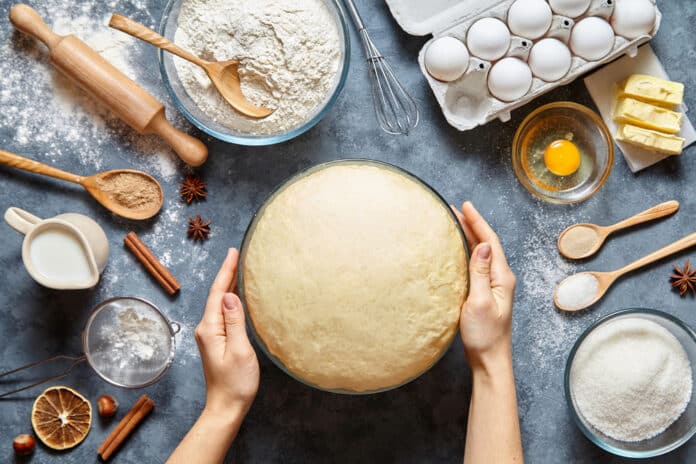Bread may seem a bit intimidating to beginner bakers, but honestly, once you have the proper technique, the right ingredients, and the best step-by-step guide (the one you’ll find here), you’ll be baking all your sandwich bread before you know it, using menial time and effort and saving you on that ever-growing grocery bill!
Ingredients And Equipment:
Ingredients Needed
4 – 5 Cups All Purpose Flour
1 Tablespoon Dry Active Yeast
¼ Cup Honey or Sugar
2 ½ Teaspoons Salt
2 Tablespoons Oil
2 Cups Warm Water
Equipment Needed
You don’t need the best high-end mixers or top-notch equipment to make the most delicious baked bread—all you need are the following:
Large Mixing Bowl
Wooden Spoon
Measuring Cups and Spoons
Clean Kitchen Towel
Bread Pan
How To Bake The Best Yeast Bread: Step-By-Step:
Step 1
Add warm water, yeast, and sugar to a large mixing bowl. Stir and allow the mixture to rest on the counter undisturbed for 5 to 10 minutes or until the top becomes foamy and bubbly.
Step 2
In another large mixing bowl, add flour, salt, oil, and the yeast mixture. Mix until a shaggy dough begins to form.
Step 3
Transfer the dough onto a floured surface and knead for 5 to 10 minutes. The dough should be soft and bounce back when touched. If it is too wet and sticky, add a bit more flour—if it is too dry, knead in more water.
Step 4
Place the dough ball in a greased mixing bowl. Cover with a kitchen towel and allow to rise in a warm location for 1 to 2 hours or until doubled in size.
Step 5
Punch the dough down and shape it into a loaf. Place the shaped dough into a greased loaf pan and allow it to prove (rise) a second time. This could be anywhere from an hour to two or until doubled in size.
Step 6
Bake for 20 to 30 minutes in a 375-degree oven. The top should be golden brown, and the bottom, when tapped, should sound hollow.
Step 7
Allow the bread to completely cool on a wired rack before slicing into it. Enjoy!
Pro Tips:
Here are some excellent tips to remember while baking, especially bread!
- Always measure correctly. Baking is a science that requires the proper measurements to form a cohesive final product.
- Temperature control. When adding warmed water to your yeast, the water should be around 110 degrees. Any warmer could kill the yeast and cause your bread not to rise.
- When proving your dough, ensure it is in a warm location, free from drafts and temperature fluctuations, for the best rise possible.
Wrapping Up The Best Homemade Yeast Bread For Beginner Bakers
There you have it! A simple yeast bread that is perfect for sandwiches, toast, or anything else. It is simple to make, inexpensive, and will be your new Sunday morning routine in no time!

